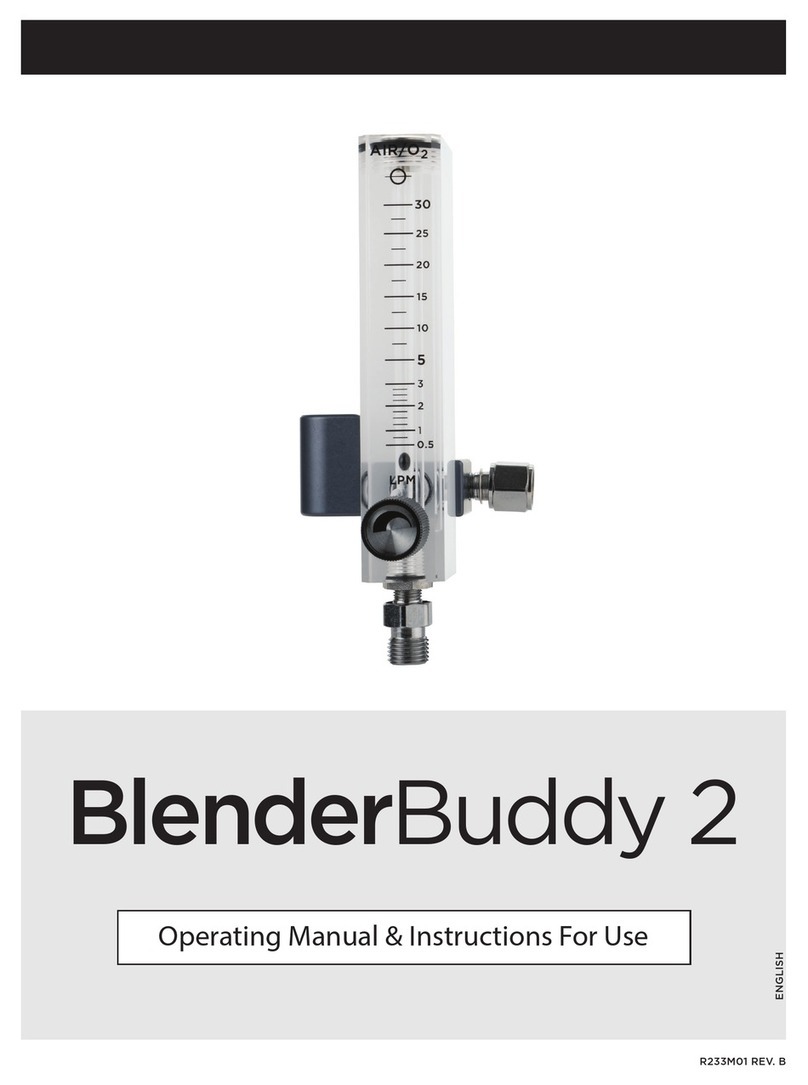
866.4.Maxtec www.maxtec.com III
• Variations in inlet gas source pressure will change the flow rate of the affected gas
and alter the percent of oxygen exiting the outlet.
• Excessive back pressure on the outlet will result in higher than indicated gas flow but
will not result in inaccurate oxygen concentration.
• Use caution to ensure the mixed gas analysis port is clean and free of any foreign
matter before each use.
• Maxtec recommends use of Maxtec analyzers/monitors which contain the Maxtec
MAX-250 line of sensors. The use of analyzers/monitors with other brands or types of
sensors may result in performance that does not conform to specifications found in
Table 1 of Section 2.2 and information found in Section 12 of this operating manual.
• Clean the MaxFLO2as recommended in section 5 of this operating manual.
Excessive cleaning can cause residue buildup on critical components which can
affect the performance of the MaxFLO2.
Do not clean the MaxFLO2with cleaning agents that contain phenols, ammonia
chloride, or chloride compounds, or that contain more than 2% glutaraldehyde. These
agents may damage the plastic components.
Do not operate the MaxFLO2at pressures below 25 PSIG (170kPaG) or above 75 PSIG
(520kPaG).
• Mount the MaxFLO2vertically and securely for correct performance. Check for
proper function as outlined in section 3 of this operating manual prior to first use.
• Dropping the device may cause injury or device damage. If the MaxFLO2is
dropped, follow the procedures outlined in Section 3 of this operating manual for a
performance check before re-using the device.
• An air inlet water filter is recommended for use with the MaxFLO2.
Do not overtighten the flow adjustment valves.
• Use only Maxtec replacement parts. Failure to do so may seriously impair the
performance of the MaxFLO2. Repair or alteration of the MaxFLO2by anyone other
than an authorized Maxtec service representative, could cause the product to fail to
perform as designed.
* References:
1. New clinical guide to surgical fire prevention. Health Devices. 2009;38(10):314-332.
2. Accidents happen - an immediate action plan. The ECRI Institute website. Available at: https://www.ecri.
org/Products/PatientSafetyQualityRiskManagement/CustomizedServices/Pages/Immediate_Action_Plan.aspx
Accessed November 2, 2009.
NOTES
Indicates supplemental information to assist in use of the device.
• There are no user serviceable components inside the MaxFLO2. All service should be
referred to a Maxtec trained service technician or to Maxtec.
• The MaxFLO2is tested for compliance with ISO 11195:1995, clause 6, and meets
requirements regarding reverse gas flow as delivered.
• The MaxFLO2has been cleaned and degreased for oxygen service prior to shipment.
Any lubricants used are designed specifically for the application. Do not use anything
other than Maxtec specified lubricants when servicing the MaxFLO2. Never use oils
on the MaxFLO2.
• Users are advised to use pressure regulators set to 50 ± 5 PSIG (345 ± 35 kPaG)
which display system pressure.
• All specifications assume the following standard environmental conditions unless
otherwise specified: ambient and sample gas temperatures of 77°F (25°C),
barometric pressure of 1 atm (101 kPa), ambient relative humidity of 50%, sample
gas relative humidity of 0%.




























